
Editor of this issue: Thomas Remeikis
 |
www.lituanus.org |
|
Copyright © 1963 Lithuanian
Students Association, Inc.
Vol. 9, No.4 - 1963
Editor of this issue: Thomas Remeikis |
|
H. NAGYS
George K. Račkus a painter of CONTRASTS
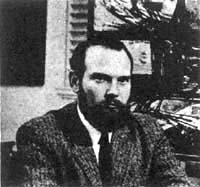
George K. Račkus, born in Lithuania in 1927 but residing in Toronto, Canada since 1931, is one of those rare artists, to whom fate was favorable in various ways. First of all, he inherited from the northern country of his birth that almost mystic relation with earth and the manifestations of nature, which is lacking frequently in the representative of modern art who was born and grew up in a metropolis. For this reason one can clearly sense in the works of Račkus that honest and vast relation with primary sources, for, as the painter himself expresses — impulse for his works derives from nature itself, the environment in which he works. It is understandable, that for such intimate ties with the surroundings and with the virgin land, the Canadian North, the sparsely inhabited expanses, were especially a suitable terrain.
Nevertheless, this nature is perceived differently by, let us say. the GROUP OF SEVEN painters and by Račkus. Painters in the GROUP OF SEVEN (founded in 1920), shattering ossified traditions of sentimental realism, were able to create an authentic, decoratively stylized landscape of their wild and lonely northern land. On the other hand, to Račkus (as also to the other Canadian painters of his generation) authentic North is only a rich mine of forms and colors, triggering off landscapes that arc forming in their subconscious. Such visual landscapes arc frequent among the compositions by Račkus and they sharply differ (in mood and technique) from surrealistic or the so-called abstract works of other painters.
Searching for a more precise definition of this difference, we will have to face another lucky star in his fate. Although born in a land of sedentary and quite peaceful land tillers, Račkus, evidently, inherited with these characteristics also a healthy measure of a searcher's and a roamer's blood (perhaps from those Lithuanian forefathers who five hundred years ago roamed throughout Europe). Račkus, thus, was not content with art studies in Canada and the United States and on several occasions traveled to Paris and Spain in order to live and learn at the source of new art movements. One of the most visible and important achievements of these travels and studies (in Paris with Andre' L' Hote) was the acquired creative confidence in himself and later the formation of individual style, liberated from the inevitably limited domination of geometric forms. Račkus has created his own free expression, obedient only to the principles of his own internal logic.
In such a manner, through inheritance and because of his wandering character, Račkus was able to integrate happily several quite different elements: peaceful, almost lyrically naive nature of a northerner, dramatic impulse, full of primitive power, of the Canadian country, and the analytical precision, rationalism and refinement of European South. Analyzing the works of Račkus, we will find all of these elements wore or less dominating in his works. Thus, for example, in his lunar or cosmic landscapes, where a desolate light of those worlds falls on skeletal shapes, volcanic crust and leady waters, we sense, even if vaguely, the loneliness of Canadian wild North together with a mystic vision of earth of the Eternal Snow, dreamt of by his forefathers. A dramatic net-like barrier of black blots in the first plane, through which is visible subtly nuanced combinations of subdued tones, are also a consequence of such dualistic experience, where a solution of purely artistic equations becomes a symbol of the relation between the conscious and subconscious human mind.
Besides the spontaneous, fearless, almost careless artistic stroke, which testifies of his self confidence and joy of creation, of his quest for emancipation from the chains of routine and materials, and, perhaps, even of an experimental mannerism, Račkus demonstrates to us in his monotypes, for example, works that were created with almost a goldsmith's patience, determination, and pietism, in which there is very little room for chance. Often these two complexes are fused in one work. And it is there, where Račkus fortunately solves that relation between lyricism and dramatism, between subtle and powerful coloration, between the nature that gave the impulse and his own vision —landscape, there he affects us deeply and truly. In the creations of Račkus undoubtedly is found that HUMAN DIMENSION, (and that, probably, is its essential feature) which provides communicative possibility for the present-day non-objective art. This possibility of communication is besides the specific aspects of painting, which are incomprehensible to the layman. Or may we say — in spite of it?
Račkus has had the following individual exhibitions of his works: Galerie Foyer des Artists, Paris (1954); British Institute, Barcelona (1956); Galena Corcarije, Ibiza (1956); Hart House, Toronto (1957); Galerie Foyer des Artists, Paris (1959); Galerie Agnes Lefort, Montreal (1960); Picture Loan Society, Toronto (1960); New Vision Centre Gallery, London (1961); Galerie des Beaux Arts, Paris (1961). Račkus also has participated in group exhibits in Paris, Spain, London, Chicago, New York, Montreal, and other cities. Račkus is represented by the following galleries: Galerie des Beaux Arts (Paris), New Vision Centre (London), Pater Deitsch Gallery (New York). Castellane Gallery (New York), Galerie Agnes Lefort (Montreal), Galeria Dearte Misrachi, Mexico. Račkus' paintings have been acquired by the Canadian National Museum in Ottawa, and by private collectors in Canada, the United States, Great Britain, France, and Spain.
Presently George Račkus lives in Clarkson, Canada, where he directs the Clarkson Artists Centre Workshop.
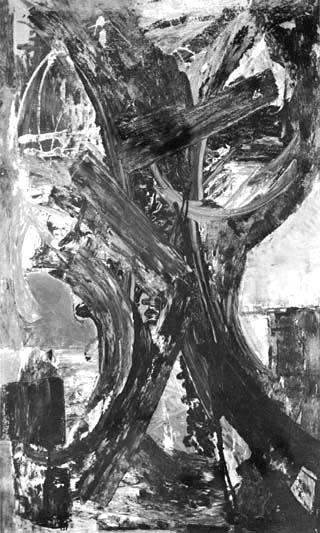
TURBULANCE __ Oil
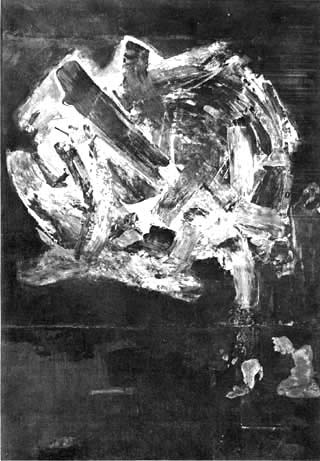
"QUE LA VIE VOIT" __ Oil
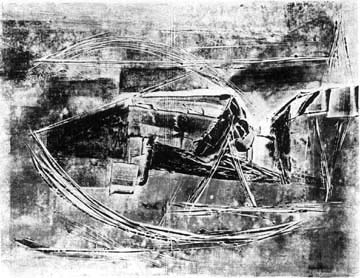
Monotype
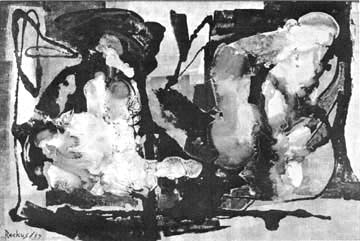
Oil 1959
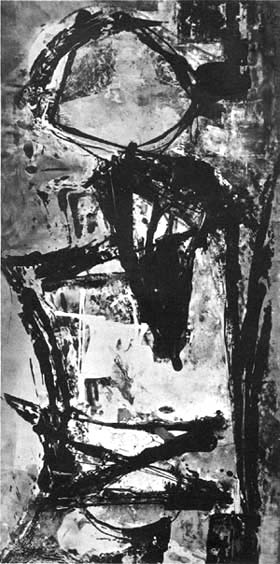
LOOKING AT THE SUN __ Oil

LA TERRE ET LE CIEL __ Oil
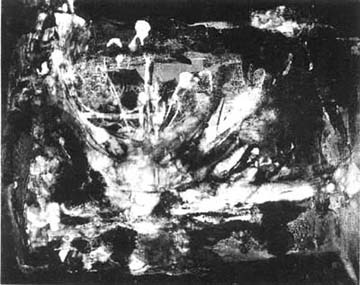
EVOLVEMENT OF FORM __ Oil
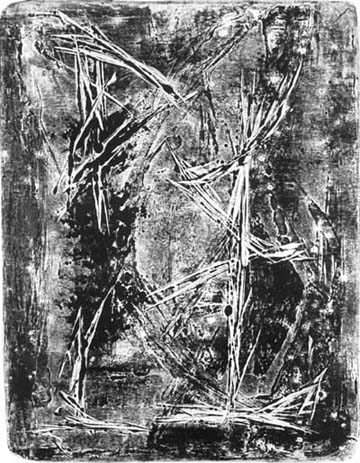
Monotype